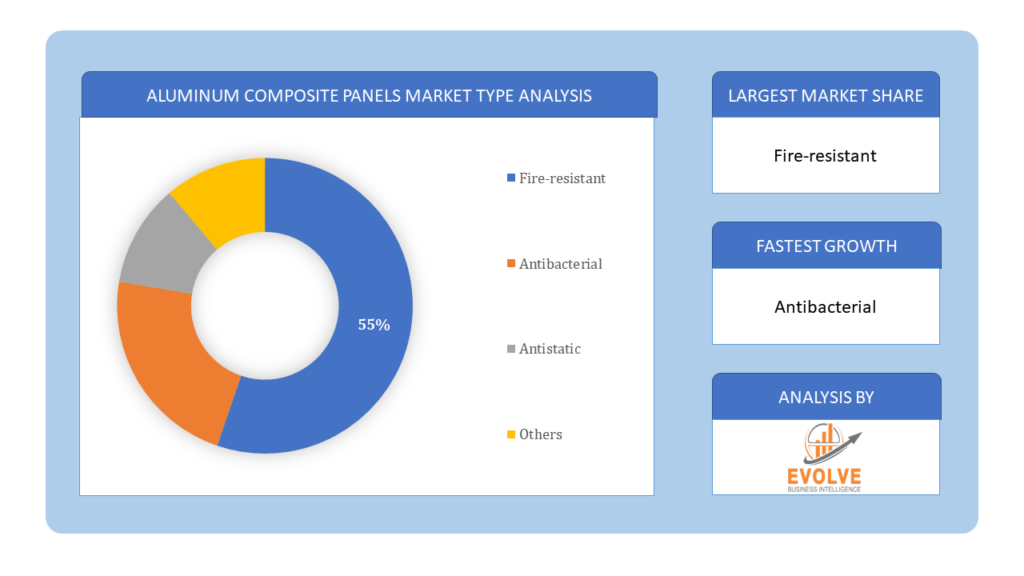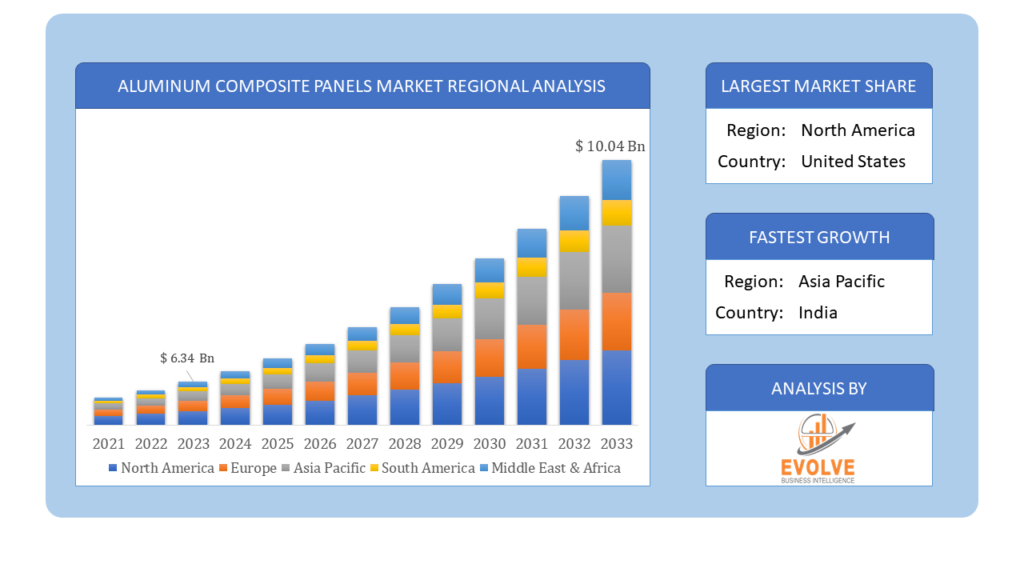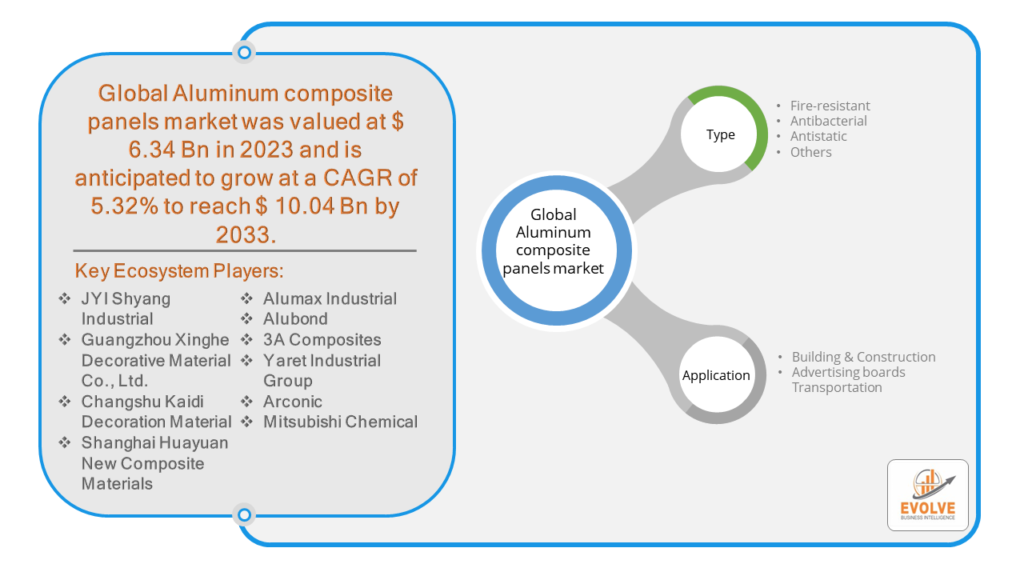Aluminum composite panels Market Overview
The Aluminum composite panels market Size is expected to reach USD 10.04 Billion by 2033. The Aluminum composite panels market industry size accounted for USD 6.34 Billion in 2023 and is expected to expand at a compound annual growth rate (CAGR) of 5.32% from 2023 to 2033. Aluminum composite panels (ACP) are flat panels consisting of two thin coil-coated aluminum sheets bonded to a non-aluminum core, typically made of polyethylene or mineral-filled material. These panels are widely used in building construction for both interior and exterior applications due to their lightweight, durability, and versatility.
The aluminum composite panels market refers to the industry involved in the manufacturing, distribution, and sale of these panels. This market serves various sectors including construction, automotive, aerospace, signage, and others. Some important factors driving the aluminum composite panels market include the growing construction industry, particularly in emerging economies, where these panels are used for cladding, facade systems, roofing, and insulation purposes.
Global Aluminum composite panels market Synopsis
COVID-19 Impact Analysis
The COVID-19 pandemic had various impacts on the aluminum composite panels (ACP) market. The pandemic disrupted global supply chains, affecting the production and distribution of ACPs. Restrictions on movement, lockdowns, and factory closures hindered the supply of raw materials, transportation, and manufacturing operations, leading to delays in delivery and project timelines. The construction industry, a major consumer of ACPs, experienced slowdowns due to lockdown measures, social distancing protocols, and economic uncertainties. Reduced construction activity, especially in commercial and residential sectors, resulted in lower demand for ACPs as building projects were postponed or canceled. The pandemic prompted changes in consumer preferences and priorities, including a greater focus on health, safety, and sustainability. This may lead to increased demand for ACPs with antimicrobial coatings, improved fire resistance, and eco-friendly features. Many ACP manufacturers and suppliers faced financial challenges due to reduced revenue, increased operating costs, and supply chain disruptions. Some companies may have struggled to maintain operations or invest in innovation and expansion initiatives.
Aluminum composite panels Market Dynamics
The major factors that have impacted the growth of Aluminum composite panels market are as follows:
Drivers:
Ø Energy Efficiency and Sustainability
ACPs contribute to energy efficiency and sustainability goals in construction. They offer thermal insulation properties, reducing heat transfer and energy consumption in buildings. Additionally, eco-friendly ACP variants made from recycled materials or featuring low VOC (volatile organic compound) coatings align with green building standards and regulations. ACPs provide a cost-effective alternative to traditional building materials like glass, stone, and steel. Their lightweight nature reduces transportation and installation costs, while their durability ensures long-term value and minimal maintenance expenses. Ongoing advancements in ACP manufacturing technologies lead to product innovations, such as improved surface finishes, enhanced fire resistance, and better structural performance. These innovations attract customers seeking high-quality, reliable ACP solutions for their projects.
Restraint:
- Perception of High Cost of Raw Materials
The main raw materials for ACPs are aluminum and polyethylene (PE). The prices of these materials can fluctuate significantly, which can impact the overall cost of ACPs. For instance, rising crude oil prices can lead to higher PE prices. This can make ACPs a less attractive option for budget-conscious construction projects. Some ACPs have been known to be flammable, which can be a safety concern for building construction. Building codes in some areas may restrict the use of ACPs or require the use of fire-retardant ACPs.
Opportunity:
⮚ Growth in the Construction Industry
The ongoing global growth in the construction sector presents a significant opportunity for the ACP market. Rapid urbanization, population growth, and infrastructure development projects in emerging economies drive the demand for high-quality building materials like ACPs. Increasing investments in residential, commercial, and industrial construction projects offer ample opportunities for ACP manufacturers and suppliers to expand their market presence. Moreover, the trend towards sustainable and energy-efficient buildings creates a demand for eco-friendly ACPs that offer thermal insulation properties and comply with green building standards. The booming construction industry, particularly in non-residential, residential, and infrastructure projects globally, will drive demand for ACPs. Their lightweight nature, insulation properties, and aesthetics make them ideal for modern buildings.
Aluminum composite panels market Segment Overview
By Type
 Based on Type, the market is segmented based on Fire Resistant, Anti-bacterial and Anti-Static. The fire-resistant segment dominated the market due to the increasing emphasis on fire safety regulations and the growing demand for building materials that offer enhanced fire resistance. Fire-resistant aluminum composite panels provide an added layer of protection against fire hazards, making them highly sought after in the construction industry. With stringent building codes and regulations to ensure occupant safety, the demand for fire-resistant panels has increased significantly.
Based on Type, the market is segmented based on Fire Resistant, Anti-bacterial and Anti-Static. The fire-resistant segment dominated the market due to the increasing emphasis on fire safety regulations and the growing demand for building materials that offer enhanced fire resistance. Fire-resistant aluminum composite panels provide an added layer of protection against fire hazards, making them highly sought after in the construction industry. With stringent building codes and regulations to ensure occupant safety, the demand for fire-resistant panels has increased significantly.
By Application
Based on Application, the market has been divided into the Building & Construction and Advertising boards Transportation. The building & construction segment dominated the market; due to the extensive use of aluminum composite panels in the construction industry for various applications. These panels offer numerous advantages, such as durability, lightweight nature, flexibility, and ease of installation, making them highly suitable for building exteriors, wall cladding, roofing, and interior decoration. As one of the largest consumers of aluminum composite panels, the building and Construction sector drives the demand for these panels.
Global Aluminum composite panels market Regional Analysis
Based on region, the global Aluminum composite panels market has been divided into North America, Europe, Asia-Pacific, the Middle East & Africa, and Latin America. North America is projected to dominate the use of the Aluminum composite panels market followed by the Asia-Pacific and Europe regions.
Aluminum composite panels North America Market
North America holds a dominant position in the Aluminum composite panels market. The North American ACP market benefits from steady construction activity, especially in the United States and Canada, driven by urbanization, renovation projects, and commercial developments. Technological advancements, such as the adoption of energy-efficient building materials, support the demand for ACPs in the region. Regulatory compliance, particularly regarding fire safety and environmental standards, poses challenges for ACP manufacturers in North America.
Aluminum composite panels Asia-Pacific Market
The Asia-Pacific region has indeed emerged as the fastest-growing market for the Aluminum composite panels market industry. APAC dominates the global ACP market, driven by rapid urbanization, population growth, and infrastructure development in countries like China, India, and Southeast Asian nations. Increasing investments in commercial and residential construction projects, coupled with government initiatives to promote sustainable building practices, fuel the demand for ACPs in the region.
Competitive Landscape
The global Aluminum composite panels market is highly competitive, with numerous players offering a wide range of software solutions. The competitive landscape is characterized by the presence of established companies, as well as emerging startups and niche players. To increase their market position and attract a wide consumer base, the businesses are employing various strategies, such as product launches, and strategic alliances.
Prominent Players:
- JyiShyang Industrial Co. Ltd.
- Guangzhou Xinghe ACP Co. Ltd.
- Msenco Metal Co. Ltd.
- Alumax Industrial Co. Ltd.
- Changshu Kaidi Decoration Material Co. Ltd.
- American Building Technologies Inc.
- Mitsubishi Chemical Corporation
- Shanghai Huayuan New Composite Materials Co. Ltd.
- Shyang Industrial Co. Ltd.
Key Development
In April 2023, Alcoa Corp. announced that it would be investing $100 million in a new ACP manufacturing plant in China. This investment is a sign of the growing demand for ACP in the Chinese market.
In June 2023, the American Architectural Manufacturers Association (AAMA) released a new standard for ACP. The new standard provides more detailed guidance on the performance and installation of ACP.
Scope of the Report
Global Aluminum composite panels Market, by Type
- Fire Resistant
- Anti-bacterial
- Anti-Static
- Other
Global Aluminum composite panels market, by Application
- Building & Construction
- Advertising boards Transportation
Global Aluminum composite panels market, by Region
- North America
- US
- Canada
- Mexico
- Europe
- UK
- Germany
- France
- Italy
- Spain
- Benelux
- Nordic
- Rest of Europe
- Asia Pacific
- China
- Japan
- South Korea
- Indonesia
- Austalia
- Malaysia
- India
- Rest of Asia Pacific
- South America
- Brazil
- Argentina
- Rest of SouthAmerica
- Middle East &Africa
- Saudi Arabia
- UAE
- Egypt
- SouthAfrica
- Rest of Middle East & Africa
| Parameters | Indicators |
|---|---|
| Market Size | 2033: $10.04 Billion |
| CAGR | 5.32% CAGR (2023-2033) |
| Base year | 2022 |
| Forecast Period | 2023-2033 |
| Historical Data | 2021 |
| Report Coverage | Revenue Forecast, Competitive Landscape, Growth Factors, and Trends |
| Key Segmentations | Type, Application |
| Geographies Covered | North America, Europe, Asia-Pacific, Latin America, Middle East, Africa |
| Key Vendors | JyiShyang Industrial Co. Ltd., Guangzhou Xinghe ACP Co. Ltd., Msenco Metal Co. Ltd., Alumax Industrial Co. Ltd., Changshu Kaidi Decoration Material Co. Ltd., American Building Technologies Inc., Mitsubishi Chemical Corporation, Shanghai Huayuan New Composite Materials Co. Ltd. and Shyang Industrial Co. Ltd. |
| Key Market Opportunities | • Growth in the Construction Industry |
| Key Market Drivers | • Energy Efficiency and Sustainability • Technological Advancements |
REPORT CONTENT BRIEF:
- High-level analysis of the current and future Aluminum composite panels market trends and opportunities
- Detailed analysis of current market drivers, restraining factors, and opportunities in the future
- Aluminum composite panels market historical market size for the year 2021, and forecast from 2023 to 2033
- Aluminum composite panels market share analysis at each product level
- Competitor analysis with detailed insight into its product segment, Government & Defense strength, and strategies adopted.
- Identifies key strategies adopted including product launches and developments, mergers and acquisitions, joint ventures, collaborations, and partnerships as well as funding taken and investment done, among others.
- To identify and understand the various factors involved in the global Aluminum composite panels market affected by the pandemic
- To provide a detailed insight into the major companies operating in the market. The profiling will include the Government & Defense health of the company’s past 2-3 years with segmental and regional revenue breakup, product offering, recent developments, SWOT analysis, and key strategies.





